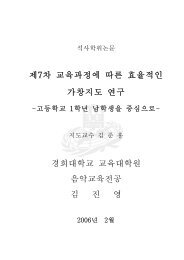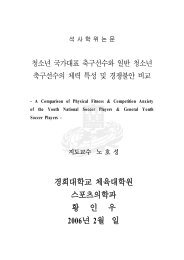경희대학교 동서의학대학원 의 학 영 양 학 과 김 선 아
경희대학교 동서의학대학원 의 학 영 양 학 과 김 선 아
경희대학교 동서의학대학원 의 학 영 양 학 과 김 선 아
You also want an ePaper? Increase the reach of your titles
YUMPU automatically turns print PDFs into web optimized ePapers that Google loves.
Ⅲ. Collagen and Silicon<br />
Silicon (Si) is a ubiquitous environmental element found mainly as insoluble<br />
silicates, although small amounts of soluble Si are also present in natural<br />
waters, chiefly as orthosilicic acid [Si(OH)4].(Farmer VC. 1986) Around<br />
neutral pH, orthosilicic acid polymerises at concentrations much above 2<br />
mM, forming a range of silica species from soluble dimers to colloids and<br />
solid phase silica (Iler RK..1979) Some plants and lower animals may<br />
promote this reaction, as they use polymeric silica for structure and<br />
growth.(Cha JN, Shimizu K, Zhou Y, Christiansen SC, Chmelka BF, Stucky<br />
GD, Morse DE. 1999; Kröger N, Deutzmann R, Sumper M. 1999; Sangster<br />
AG, Hodson MJ. 1986) The normal diet contains orthosilicic acid present in<br />
water or following hydrolysis of foods in the gastrointestinal tract,<br />
nonhydrolyzed polymeric silica from plants (Pennington JA. 1991), and<br />
silicates due mainly to soil and dust contamination or as food additives<br />
(Hansen M, Marsden J. 1987; Villota R, Hawkes JG. 1986). Absorption<br />
studies have shown that only orthosilicic acid is in a bioavailable form with<br />
uptake in humans exceeding 50% of the ingested dose (Jugdaohsingh R,<br />
Reffitt DM, Oldham C, Day JP, Fifield K, Thompson RPH, et al. 2000; Reffitt<br />
DM, Jugdaohsingh R, Thompson RPH, Powell JJ. 1999). Fasting<br />
concentrations of Si in plasma are 2-10 M, rising to 20-30 M after meals,<br />
and approximately 700 mol/day is normally excreted in urine.<br />
In 1972, Carlisle (Carlisle EM. 1972) and Schwarz and Milne (Schwarz K,<br />
Milne DB. 1972) first reported that silicon deficiency in chicks and rats led<br />
to abnormally shaped bones and defective cartilagenous tissue, both of<br />
- 38 -

















